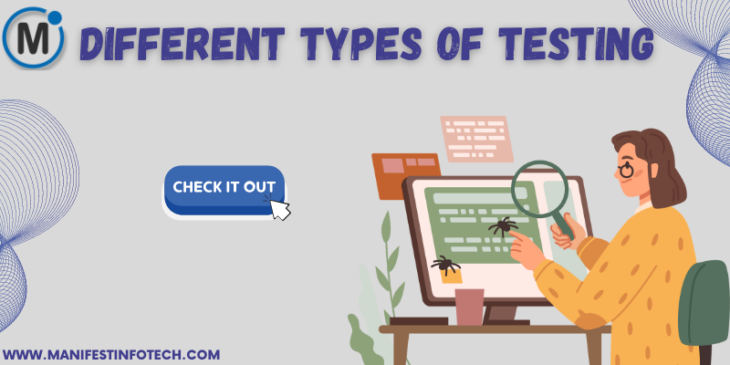
Testing is a crucial aspect of software development and various types of testing are performed at different stages of the development lifecycle to ensure the quality, reliability, and functionality of software systems. Here are some common types of testing:
𝟏. 𝐔𝐧𝐢𝐭 𝐓𝐞𝐬𝐭𝐢𝐧𝐠: This involves testing individual units or components of the software in isolation. It ensures that each unit functions as intended. Developers typically write unit tests to validate the behavior of small code segments.
𝟐. 𝐈𝐧𝐭𝐞𝐠𝐫𝐚𝐭𝐢𝐨𝐧 𝐓𝐞𝐬𝐭𝐢𝐧𝐠: This type of testing focuses on testing the interactions between different units or components. It ensures that these units work together as expected and identify any issues arising from their interactions.
𝟑. 𝐅𝐮𝐧𝐜𝐭𝐢𝐨𝐧𝐚𝐥 𝐓𝐞𝐬𝐭𝐢𝐧𝐠: This type of testing verifies whether the software’s functions or features behave according to specifications. It tests the software’s functionality against the requirements and user expectations.
𝟒. 𝐑𝐞𝐠𝐫𝐞𝐬𝐬𝐢𝐨𝐧 𝐓𝐞𝐬𝐭𝐢𝐧𝐠: When new features or changes are added to the software, regression testing ensures that the existing functionality hasn’t been negatively affected. It involves retesting the entire application or specific areas to catch any unintended side effects.
𝟓. 𝐔𝐬𝐞𝐫 𝐀𝐜𝐜𝐞𝐩𝐭𝐚𝐧𝐜𝐞 𝐓𝐞𝐬𝐭𝐢𝐧𝐠 (𝐔𝐀𝐓): UAT involves having end-users or clients test the software to ensure it meets their needs and expectations. It’s the final step before the software is released.
𝟔. 𝐏𝐞𝐫𝐟𝐨𝐫𝐦𝐚𝐧𝐜𝐞 𝐓𝐞𝐬𝐭𝐢𝐧𝐠: This type of testing assesses the software’s performance, such as its speed, responsiveness, scalability, and stability, under different conditions like high loads or stress.
𝟕. 𝐋𝐨𝐚𝐝 𝐓𝐞𝐬𝐭𝐢𝐧𝐠: Load testing checks how well the software performs under anticipated load conditions. It helps identify performance bottlenecks and determine if the application can handle the expected number of users.
𝟖. 𝐒𝐭𝐫𝐞𝐬𝐬 𝐓𝐞𝐬𝐭𝐢𝐧𝐠: Stress testing goes beyond load testing by pushing the system to its limits, often beyond what it’s designed to handle, to understand how it behaves under extreme conditions.
𝟗. 𝐒𝐞𝐜𝐮𝐫𝐢𝐭𝐲 𝐓𝐞𝐬𝐭𝐢𝐧𝐠: Security testing assesses the software’s vulnerabilities and weaknesses to prevent unauthorized access, data breaches, and other security risks.
𝟏𝟎. 𝐔𝐬𝐚𝐛𝐢𝐥𝐢𝐭𝐲 𝐓𝐞𝐬𝐭𝐢𝐧𝐠: Usability testing evaluates the software’s user-friendliness by assessing how well users can interact with and navigate the application. It focuses on user experience.
𝟏𝟏. 𝐂𝐨𝐦𝐩𝐚𝐭𝐢𝐛𝐢𝐥𝐢𝐭𝐲 𝐓𝐞𝐬𝐭𝐢𝐧𝐠: This type of testing ensures that the software works correctly across various devices, browsers, operating systems, and configurations.
𝟏𝟐. 𝐄𝐱𝐩𝐥𝐨𝐫𝐚𝐭𝐨𝐫𝐲 𝐓𝐞𝐬𝐭𝐢𝐧𝐠: Testers, without predefined scripts, explore the application to identify defects and unexpected behaviors. It relies on testers’ creativity and intuition.
𝟏𝟑. 𝐀𝐥𝐩𝐡𝐚 𝐓𝐞𝐬𝐭𝐢𝐧𝐠: Alpha testing is conducted by internal teams before the software is released to a larger audience. It aims to identify major issues and gather feedback for improvements.
𝟏𝟒. 𝐁𝐞𝐭𝐚 𝐓𝐞𝐬𝐭𝐢𝐧𝐠: Beta testing involves releasing a version of the software to a limited group of external users who provide feedback, allowing developers to make final adjustments before the official release.
𝟏𝟓. 𝐀𝐮𝐭𝐨𝐦𝐚𝐭𝐞𝐝 𝐓𝐞𝐬𝐭𝐢𝐧𝐠: Automated tests are scripts that run automatically to validate software functionality. They include unit tests, integration tests, and more, which can be repeated quickly and efficiently.
𝟏𝟔. 𝐍𝐨𝐧-𝐅𝐮𝐧𝐜𝐭𝐢𝐨𝐧𝐚𝐥 𝐓𝐞𝐬𝐭𝐢𝐧𝐠: This category includes testing non-functional aspects such as performance, security, reliability, and other quality attributes.
If you are looking for any services related to Website Development, App Development, Digital Marketing and SEO, just email us at nchouksey@manifestinfotech.com or Skype id: live:76bad32bff24d30d
𝐅𝐨𝐥𝐥𝐨𝐰 𝐔𝐬:
𝐋𝐢𝐧𝐤𝐞𝐝𝐢𝐧: linkedin.com/company/manifestinfotech
𝐅𝐚𝐜𝐞𝐛𝐨𝐨𝐤: facebook.com/manifestinfotech/
𝐈𝐧𝐬𝐭𝐚𝐠𝐫𝐚𝐦: instagram.com/manifestinfotech/
𝐓𝐰𝐢𝐭𝐭𝐞𝐫: twitter.com/Manifest_info
#SoftwareTesting #QualityAssurance #QATesting #TestingTypes #TestAutomation #ManualTesting #AutomatedTesting #RegressionTesting #PerformanceTesting #LoadTesting #StressTesting #SecurityTesting #PenetrationTesting #UsabilityTesting #AccessibilityTesting #CompatibilityTesting #IntegrationTesting #UnitTesting #FunctionalTesting #UserAcceptanceTesting #ExploratoryTesting #SmokeTesting #SanityTesting #EndToEndTesting #APITesting #MobileAppTesting #CrossBrowserTesting #LocalizationTesting #GlobalizationTesting #ContinuousIntegration #ContinuousTesting #CI_CDTesting #ShiftLeftTesting #TestingMetrics #TestingBestPractices #BugTracking #TestCases #TestEnvironment #TestCoverage #QAProcess #TestStrategy #PostReleaseTesting #TestingChallenges #TestingSuccess #TestingFailures